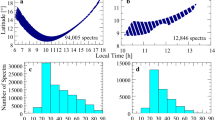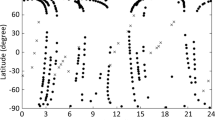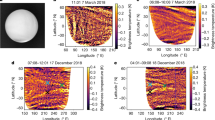Abstract
The atmosphere and ionosphere of Venus have been studied in the past by spacecraft with remote sensing1,2,3,4 or in situ techniques3,4. These early missions, however, have left us with questions about, for example, the atmospheric structure in the transition region from the upper troposphere to the lower mesosphere (50–90 km) and the remarkably variable structure of the ionosphere. Observations become increasingly difficult within and below the global cloud deck (<50 km altitude), where strong absorption greatly limits the available investigative spectrum to a few infrared windows and the radio range. Here we report radio-sounding results from the first Venus Express Radio Science5 (VeRa) occultation season. We determine the fine structure in temperatures at upper cloud-deck altitudes, detect a distinct day–night temperature difference in the southern middle atmosphere, and track day-to-day changes in Venus’ ionosphere.
This is a preview of subscription content, access via your institution
Access options
Subscribe to this journal
Receive 51 print issues and online access
$199.00 per year
only $3.90 per issue
Buy this article
- Purchase on Springer Link
- Instant access to full article PDF
Prices may be subject to local taxes which are calculated during checkout





Similar content being viewed by others
References
Mariner Stanford Group. Venus: ionosphere and atmosphere as measured by dual-frequency radio occultation of Mariner V. Science 158, 1678–1683 (1967)
Howard, H. T. et al. Venus: mass, gravity field, atmosphere, and ionosphere as measured by the Mariner 10 dual-frequency radio system. Science 183, 1297–1301 (1974)
Hunten, D. M., Colin, L., Donahue, T. M. & Moroz, V. I. (eds) Venus (Univ. Arizona Press, Tucson, 1983)
Bougher, S. W., Hunten, D. M. & Phillips, R. J. (eds) Venus II: Geology, Geophysics, Atmosphere, and Solar Wind Environment (Univ. Arizona Press, Tucson, 1997)
Häusler, B. et al. Radio science investigations by VeRa onboard the Venus Express spacecraft. Planet. Space Sci. 54, 1315–1335 (2006)
Fjeldbo, G., Kliore, A. J. & Eshleman, V. R. The neutral atmosphere of Venus as studied with the Mariner V radio occultation experiments. Astron. J. 76, 123–140 (1971)
von Zahn, U., Kumar, S., Niemann, H. & Prinn, R. in Venus (eds Hunten, D. M., Colin, L., Donahue, T. M. & Moroz, V. I.) 299–430 (Univ. Arizona Press, Tucson, 1983)
Bertaux, J. L. et al. A warm layer in Venus’cryosphere and high-altitude measurements of HF, HCl, H2O and HDO. Nature 10.1038/nature05974 (thisissue).
Kliore, A. J. & Patel, I. R. Vertical structure of the atmosphere of Venus from Pioneer Venus Orbiter radio occultations. J. Geophys. Res. 85, 7957–7962 (1980)
Jenkins, J. M., Steffes, P. G., Hinson, D. P., Twicken, J. D. & Tyler, G. L. Radio occultation studies of the Venus atmosphere with the Magellan spacecraft. 2. Results from the October 1991 experiments. Icarus 110, 79–93 (1994)
Fox, J. L. & Sung, K. Y. Solar activity variations of the Venus thermosphere/ionosphere. J. Geophys. Res. 106, 21305–21336 (2001)
Fox, J. L. & Kliore, A. J. in Venus II: Geology, Geophysics, Atmosphere, and Solar Wind Environment (eds Bougher, S. W., Hunten, D. M. & Philips, R. J.) 161–188 (Univ. Arizona Press, Tucson, 1997)
Kliore, A. J. & Luhmann, J. G. Solar cycle effects on the structure of the electron density profiles in the dayside ionosphere of Venus. J. Geophys. Res. 96, 21281–21289 (1991)
Kliore, A. J., Luhmann, J. G. & Zhang, M. H. G. The effect of the solar cycle on the maintenance of the nightside ionosphere of Venus. J. Geophys. Res. 96, 11065–11071 (1991)
Taylor, F. W. et al. Structure and meteorology of the middle atmosphere of Venus: infrared remote sensing from the Pioneer orbiter. J. Geophys. Res. 85, 7963–8006 (1980)
Acknowledgements
We thank H. Svedhem, F. Jansen, the Project Science Team at ESTEC and the Flight Control Team at ESOC for continuous support. The German and the US part of VeRa are supported by DLR, Bonn-Oberkassel and by a contract with NASA, respectively.
Author information
Authors and Affiliations
Corresponding author
Supplementary information
Supplementary Figures
The file contains Supplementary Figures S1-S2 with Legends. (PDF 362 kb)
Rights and permissions
About this article
Cite this article
Pätzold, M., Häusler, B., Bird, M. et al. The structure of Venus’ middle atmosphere and ionosphere. Nature 450, 657–660 (2007). https://doi.org/10.1038/nature06239
Received:
Accepted:
Published:
Issue Date:
DOI: https://doi.org/10.1038/nature06239
This article is cited by
-
Direct production of molecular oxygen from carbon dioxide and helium ion collisions
Communications Chemistry (2023)
-
Venus, the Planet: Introduction to the Evolution of Earth’s Sister Planet
Space Science Reviews (2023)
-
Venus sample return mission revisited
Experimental Astronomy (2022)
-
Evaluation of a method to retrieve temperature and wind velocity profiles of the Venusian nightside mesosphere from mid-infrared CO2 absorption line observed by heterodyne spectroscopy
Earth, Planets and Space (2020)
-
Calibration Techniques for Studying Venus and Mars Atmospheres
Aerotecnica Missili & Spazio (2020)
Comments
By submitting a comment you agree to abide by our Terms and Community Guidelines. If you find something abusive or that does not comply with our terms or guidelines please flag it as inappropriate.



